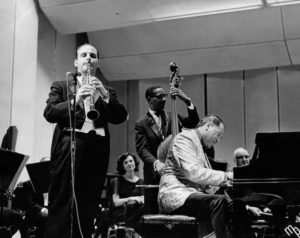
The Importance of the Familiar

You know how it feels when you unexpectedly hear a familiar piece of music—any kind of music? You get that jolt and you say, oh I love that song/piece. Or you say, wait, I love that, what is that? And maybe you hit Shazam on your watch or phone to confirm what it is and listen again.
There’s some evidence that familiarity increases enjoyment when listening to music. Dick Waller (AKA Dad) has been telling me this for years.
Dad was principal (translates as #1 player) clarinetist in the Cincinnati Symphony, played and taught at the Aspen Music Festival for many summers, and after ‘retiring’ he went on to be artistic director at Linton Chamber Music. He’s taught me SO much about innovation in the arts and especially about reaching new audiences for classical music. He worked on audience development and engagement A LOT as a musician and an administrator.
Finding More Music Lovers
At Linton, he was a field leader, producing a program for younger people (what we used to call YPs) in Cincinnati’s City Council Chambers (great acoustics in that old building). He started by creating a committee of his target audience to help develop the concept and build a mailing list. The programs started right after work with drinks and donated restaurant bites in city hall’s stunning lobby and continued with a short, accessible music program (about an hour), that included an MC, who skillfully made the program more interesting with backstory on composers and era, plus interviews with the charming (usually youngish) guest musicians. Dad urged all the performers to dress casually too.
Accessible music, which includes familiar music, was key to Dad’s programming.
Sinatra and Santana Sing Brahms
I thought about this at an Aspen Music Festival event last week. Spending the week there with Dad, we heard music every day. One morning we went to the dress rehearsal of the Chamber Symphony concert in the Aspen tent. (This is a brilliant concept: small fee for an informal event that offers a glimpse of how-the-magic-happens, where the culture accepts reading and silent phone use during the performance!)
When the orchestra began playing the 3rd movement of Brahms Third Symphony (written in 1883), I felt that familiar-effect—and nearly cried, so strong was my emotional reaction. (Does music do that to you?)
Cincinnati Symphony Orchestra via WCET
I grew up listening to a lot of classical music, so it’s often familiar to me. But this was more so. I pulled out my phone and googled Brahms Third. Whoa. There’s an entire Wikipedia article about Brahms Third in popular culture—mostly the 3rd movement.
Here’s Frank Sinatra singing “Take My Love”, which he co-wrote in 1951. James Kaplan, a Sinatra biographer, says the song “turned a perfectly honest theme from Brahms’ Third Symphony into an outright weeper”.
The theme has also been used in songs sung by Jane Birkin (arrangement and lyrics by Serge Gainsbourg) and Carlos Santana (with lyrics by Dave Matthews), multiple films, and a computer game.
Have you heard it before?
The Familiar-New-Familiar Music Sandwich
Dad says the trick is programming the familiar with the new or unfamiliar. Bring people in with the stuff they know they will like, start and end the concert with the pieces that generate the emotion that comes with the stuff we know. Then offer something new, yet accessible and worthy, in-between.
On another day in Aspen, we heard a chamber group play a new piece. One woman in the audience captured our thinking when she whispered, “That wasn’t my favorite.” Another, sitting next to my father asked, “Are you staying for the Brahms? That’s the reward.” (Yes, we heard Brahms at 3 out of 4 concerts. This was Brahms’ String Sextet with Robert McDuffie and Aspen students.)
That concert started with a deconstructed version of America the Beautiful—familiar, while beautifully different. McDuffie played directly into the beginning of the Philip Glass pieces that followed. Glass’ music always seems sort of familiar even when it isn’t—and certainly becomes familiar by the end. We didn’t ❤️ the contemporary music in the middle, possibly because it isn’t the sort of great, new piece that has to be the in-between according to Dad’s formula. Still, our memory of that concert will be fine because of the welcoming, wonderful, and familiar music on either side.

I think your dad was on to something. But more than simply the sequencing of different parts of programming we can look at the conceptual placement of newness amidst familiarity. I think your dad has something bigger to teach than simply advice for concert programming.
I want to say this because I think familiarity is so often misunderstood, both as something that places things for us, specifically AS understood, but also as a background against which things of lesser familiarity get framed.
Let me explain. Something else I read this morning was an essay describing the soundscape of Boston. It was very poetic, and enjoyable to read. It also described itself as attempting something akin to “dancing about architecture”. Talking about sounds seems to imply a gulf that is navigated if at all only with extreme difficulty. In a sense, a parallel difficulty might be the gap between the familiar and the new. One thing is simply framed by the other, and that is how we come to make sense, as best we can.
One question I had in that other essay was about the use of the word ‘sound’. It came up 41 times and ‘noise’ only 3. But the use of ‘noise’ did not seem to indicate a difference in meaning, it was being used interchangeably, it seemed. But my sense is that not everything we hear is of equal value, and that it does make a difference to have some discriminations. The difference between the familiar and the new being an obvious and important difference.
With a bit of digging I uncovered that ‘noise’ is often meant to refer to sounds we find disagreeable. ‘Noise”, some suggest, comes from the Latin ‘nausea’.
But there is also a difference that comes between what gets described as ‘signal’ and ‘noise’. In this sense signal is information bearing sound and noise is meaningless background. It is this distinction that I find most interesting. Sound and noise are not simply different ways of saying the same thing, they are the difference between what matters to us and what doesn’t. Sounds are intelligible. We make sense of sound because it carries meaning with it. Noise we cannot place. It has no defined role in our lives. A noise can come to mean things only once we have given it a context that provides for it a sense.
This is just what your dad was suggesting. Something new stands on its own, without relation to anything we have a place for in our lives. But new things CAN be given places. We can take something new and sandwich it between the familiar parts of our world. We can give new things sense by extending the sense of our world to greet them.
The truth is that things are familiar and new by degrees. Only noise has no real place. Music is at least music, even if we have trouble framing it in familiar musical terms. It is only new in the sense that it is new *music*. But by degrees we can make it something more familiar by providing it more context. We bring it more and more into our world by framing it in ways that we understand, by surrounding it with things that make sense. It becomes more meaningful by connecting up with the meaning we already have.
And it is interesting to note that one person’s familiarity is another’s new. I was not familiar with the Brahms piece, but I knew Sinatra. It wasn’t Sinatra’s version that was new for me but the Brahms. Just as for others the Brahms piece was familiar but Sinatra’s version something new.
What this helps show is that framing is fundamental to how things get understood. Which seems entirely the point of your work on the ripple effect. And the trick is always turning the noise (in both its senses) into sound.
Carter, your comment is the sort of response that writers dream about. You’ve expanded my thinking and given the post more meaning.
I love the concept of noise as a contrast to signal. And of course, it’s spectacular to compare the importance of the familiar in classical music to everyday communications, especially explainer/community building comms like the Ripple Effect approach to talking about art.
When Topos does research to find a new way to communicate an idea, we’re often looking for something new that nevertheless seems like common sense to the broadest group of people possible — so we’re looking for something that is familiar, if not not KNOWN.
That’s how I see the Sinatra-Brahms story. For you the Sinatra was familiar, and maybe even known. That makes the Brahms more familiar, though not KNOWN. I expect that’s how the Brahms would be for most people. The fact that something is familiar makes it more enjoyable, easier to hear.
Wrapping new music in the familiar only works—as DAD says—when it’s good. (Though he will tell you that he sometimes has to listen to new music a few times to decide how he feels.) I guess for me, the not-good sounds more like noise, even when it is wrapped in the familiar.
THANK YOU! And if you haven’t gone to listen to the Santana/Matthews—I recommend it! A very different take on Brahms, and one that the musicians apparently have not acknowledged. Hmmmmm.
At some point you realize because of that and usually unique voice of Frank Sinatra and the way he learned a phrase makes him an iconic American Entertainer. Doesn’t much matter what film is in because of some point you’re not looking at anyone but himDo becausebecause he has a charisma the few singers and or actors ever ever possess.